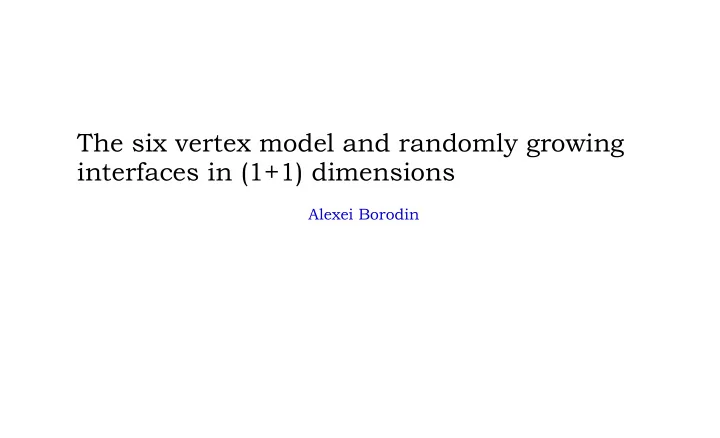

The six vertex model and randomly growing interfaces in (1+1) dimensions Alexei Borodin
Through the last two decades, the large time asymptotics of a number of out-of-equilibrium random growth models in (1+1)d have been analyzed (Kardar-Parisi-Zhang universality class, Tracy-Widom distributions). It turns out that the solvability of all the non-free-fermion ones can be traced to the Yang-Baxter integrability of the six vertex model. Unraveling the basic structure that underlies the solvability leads to more powerful systems that go down to new analyzable physical (local) models and new phenomena.
The six vertex model (Pauling, 1935) In 'square ice', which has been seen between graphene sheets, water molecules lock flat in a right-angled formation. The structure is strikingly different from familiar hexagonal ice (right). From <http://www.nature.com/news/graphene-sandwich-makes- new-form-of-ice-1.17175> Lieb in 1967 computed the partition function of the square ice on a large torus - an estimate for the residual entropy of real ice.
The six vertex model and the XXZ quantum spin chain Encode rows of vertical edges as vectors in View products of weights of verticles in a horizontal row as matrix elements of an operator . For a certain choice of the six weights, the log derivative of this operator is This is the Hamiltonian of a quantum mechanical (Heisenberg) model of ferromagentism known as the XXZ model.
The six vertex model vs. dimers Partition function is the Partition function is a Izergin-Korepin det. product, e.g. Are there instances of the six vertex model with the partition function that looks like a product, not determinant?
The higher spin six vertex model [Kulish-Reshtikhin-Sklyanin '81] The Yang-Baxter (star-triangle) equation:
A product partition function Theorem [B.'14] The partition function normalized by equals Convergence:
A product partition function In the top part, one can replace occupied (black) horizontal edges and uoccupied ones. Then one has to normalize vertex weights in the top part rather than the partition function.
Proof - operator approach In define In infinite volume, and need to be normalized: is the length of the strip
Proof - operator approach The Yang-Baxter equation is equivalent to certain quadratic commutation relations between these operators. For example, Assuming , in infinite volume one gets The result now follows from
Proof - pictorial approach A. Sportiello: This is also an exact sampling algorithm!
Sampling
Removing the first column Making the 0 th column deterministic turns it into a boundary condition. If all 0 th column vertices in the bottom half look like , the partition function has the factor , thus must vanish at
A stochastic model Specialize as Theorem [B. '14, Corwin-Petrov '15] The resulting random paths in the bottom part of the picture can be constructed recursively via
An inhomogeneous stochastic model Specialize as Theorem [B.-Petrov '16] The resulting random paths in the bottom part of the picture can be constructed recursively via with additional sets of parameters
Sampling (the six vertex case) Courtesy of Leo Petrov
q-Moments of the height function Theorem [B.-Petrov '16] For any
The six vertex case- an asymptotic corollary Theorem [B-Corwin-Gorin '14] Assume Then for where is explicit, is the GUE Tracy-Widom distribution. Gwa-Spohn (1992): This is a member of the KPZ universality class. This class was related to TW in late 1990's.
New applications so far (2+1)d dynamics that preserves the 6-vertex Gibbs • measures on a torus (hypothetically, in (2+1)d AKPZ class) [B.-Bufetov '15] Unusual phase transitions in the inhomogeneous setting • [B.-Petrov, in preparation] Baik-Ben Arous-Peche type phase transition in ASEP • [B.-Aggarwal, in preparation] Fluctuations along characteristics in equilibrium ASEP • [Aggarwal, in preparation]
Nuts and bolts - symmetric functions These are symmetric rational functions. Also, and there is a similar formula for (homogeneous system) .
Cauchy identities The commutation relation is equivalent to the skew Cauchy identity with Iterations show that are eigenfunctions of , and give the usual Cauchy identity
Orthogonality Theorem [Povolotsky '13, B.-Corwin-Petrov-Sasamoto '14-15, B.-Petrov '16] This orthogonality relation and the Cauchy identities are two basic ingredients that are needed to prove the q-moment formula. This relation also described a selection rule for "rapidities" u that turn the "off-shell Bethe vectors" F(u) into a complete orthogonal basis.
Summary The higher spin six vertex model allows domains for which the • partition functions are simple products. A specialization of spectral parameters on a part of such a • domain gives a Markovian ("stochastic") model. For the stochastic model, a large set of observables can be • explicitly averaged, leading to asymptotic analysis. The key tool is a new family of symmetric rational functions • whose properties are derived directly from the Yang-Baxter eq.
Recommend
More recommend